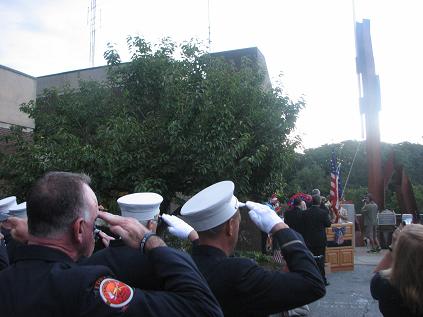TZ Bridge Vital to Healthy White Plains

White Plains has long been called a transportation hub, situated in central Westchester County, just 30 minutes north of Manhattan, with an airport, major highways and the Metro-North Harlem train line all converging within a short distance of each other. This is why the rebuilding of the Tappan Zee Bridge is of major concern to business owners and government officials in the city. The new bridge will not only enable easier access to White Plains, the several year construction project will also bring activity into the area.
Members of the White Plains Business Improvement District, Mayor Tom Roach, representatives from other local government agencies and local business people gathered at the New York Power Authority building last week to hear a presentation and ask questions about the new bridge’s relevance to White Plains.
Brian Coneybeare, Governor Andrew Cuomo’s special advisor for the Tappan Zee Bridge, explained the safety issues that made construction of a new bridge as soon as possible an immediate concern. “Keeping the traffic flowing into and out of White Plains is like the region’s life blood,” Coneybeare said. “That blood flow serves the brain of Westchester County and that brain is White Plains.” When the flow to the brain is congested, the brain is hurt and the whole region is hurt, he further noted.
Coneybeare cited tight lanes, a lack of grading and banking on the curves and no shoulders as reasons why accidents on the bridge are increasing and traffic pile ups have become common place. Explaining that once the determination was made to focus on the bridge and not the entire I-287 corridor, development options became clear and timelines could be sped up.
“The current bridge is not up to seismic code, Coneybeare explained. If there was an earthquake or a large shipping vessel hit one of the pilings, the bridge would fracture,” he said. “It would cost from $3 to $4 billion to fix the existing bridge.” That apparently includes turning the bridge into a park, which is one reason why the idea was scrapped. Coneybeare also noted that navigation experts had determined large vessels could not manage multiple rows of pilings and the water currents flowing beneath the bridge would be affected interfering with fish migration patterns.
Coneybeare says he expects a final decision on the bid and design will be made in about 30 days. “There are three bids in the final review. Ten different teams are evaluating the presentations and one of these will be selected,” he said. New York State owns all the bids submitted, so when down the road a mass transit option is implemented, the state will be able to take elements from different bids if it wants to. The state is using a design/build concept, written into law this past December, so that contracts are comprehensive and binding. “If the bidding team left something out or if the project takes longer than expected, it’s the contractor’s problem to solve, not the state’s,” Coneybeare said.
The infrastructure for a mass transit option is being built into the initial design. Whether that will be bus rapid transit or a commuter train, remains for future investigation. If a train element is eventually included, it could link to the Metro-North Harlem line that goes right through White Plains. Right now there are not enough people taking mass transit on the I-287 corridor to decide which is the viable option, according to Coneybeare. “We’re trying to get people out of their cars and into mass transit first,” he said.
The new bridge should last 150, possibly 200 years, according to Coneybeare, and will actually be two bridges, one traveling north, the other south with a 96-foot wide span. Each bridge will have four dedicated traffic lanes, shoulders and emergency stopping and emergency vehicle lanes. The north bridge will also include walking and biking lanes. “There will be no more shifting of lanes to get to the EZ Pass tolls,” Coneybeare contends. “The decision might be made to go all electronic, so if you don’t have EZ Pass, a camera would take a photo of your license plate and you’d get a bill in the mail.”
Regarding those tolls, Coneybeare agrees the $14 scenario is too high and something in the $8 to $9 range is more likely. However, commuters and residents would probably receive a 40 percent discount and consideration is being given to increasing commercial toll prices.

